
Coalition of International, Regional and Local Organizations Comment on Hermosa Draft EA
|

|
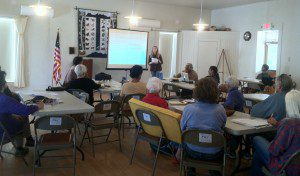
PARA, Jenny Neeley and Sergio Avila from Sky Island Alliance teamed up again to host a NEPA comment workshop at Cady Hall in Patagonia on March 26, 2014. Discussed were the potential issues of the Forest Service’s Draft Environmental Assessment of the AZ Mining Inc / Wildcat Silver / Arizona Minerals Hermosa mining exploration proposal and how to comment effectively on it.
 Jenny Neeley reprised her role as our National Environmental Policy Act (NEPA) expert for tips on filing public comments on the Hermosa draft Environmental Assessment (EA) released by the Coronado National Forest. The purpose of an Environmental Assessment is to determine whether the impacts of a project will be significant. The goal for our comments on the draft EA is to demonstrate that the Hermosa project impacts will be significant so that the Forest Service conducts a more detailed and comprehensive Environmental Impact Statement. Read more tips for writing comments here.
Jenny Neeley reprised her role as our National Environmental Policy Act (NEPA) expert for tips on filing public comments on the Hermosa draft Environmental Assessment (EA) released by the Coronado National Forest. The purpose of an Environmental Assessment is to determine whether the impacts of a project will be significant. The goal for our comments on the draft EA is to demonstrate that the Hermosa project impacts will be significant so that the Forest Service conducts a more detailed and comprehensive Environmental Impact Statement. Read more tips for writing comments here.
PARA board member Cliff Hirsch gave a summary of the expected activities proposed by the AZ Mining Inc / Wildcat Silver / Arizona Minerals Hermosa exploratory drilling project located 6 miles southeast of the Town of Patagonia. The project activities encompasses 7350 acres of both Coronado National Forest and private land. It is also expected to use 3,525,800 gallons of groundwater pumped from within the Town of Patagonia Municipal Supply Watershed. Click here for talking points and Hermosa project summary.
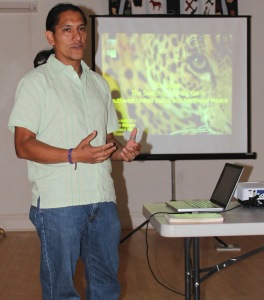
SIA Biologist, Sergio Avila
SIA biologist Sergio Avila discussed the amazing biodiversity found in the Patagonia Mountains during the Bioblitz event conducted in April 2013. View the Bioblitz report here. The results from the Bioblitz and the ongoing wildlife tracking in the Patagonia Mountains demonstrate the importance of the Patagonias as a wildlife corridor and biological hotspot in the sky island mountain ranges of southern Arizona and northern Mexico. Click for a list of Federally Threatened, Endangered and Sensitive Species in the Patagonia Mountains of the Coronado National Forest in southern Arizona.
The Hermosa draft Environmental Assessment is available at the Patagonia Public Library and online at the Forest Service website on the Hermosa project page: http://www.fs.fed.us/nepa/nepa_project_exp.php?project=41158.
Thank you everyone for your participation. The Forest Service received 200 public scoping comments on the Hermosa Plan of Operation. Let’s send them 200 more on the draft EA! Deadline to submit comments is Friday, April 11, 2014.
By Jenny Neeley
1. Consider whether the effects significant. If they are, then the Forest Service must prepare a more detailed Environmental Impact Statement (EIS) rather than an Environmental Assessment (EA). When deciding whether the impacts are “significant” NEPA implementing regulations (40 CFR § 1508.27) require that agencies consider both:
2. Make your comments “substantive” and specific. The Forest Service is required by law to respond to all “substantive” comments submitted during the public comment period; the more specific and focused your comments are, the more detailed the response must be from the agency. Comments that simply say “I am opposed to this project” will not, by themselves, require a response from the agency.
3. Include the specific sections, pages and/or topics you are referencing in the Draft EA. To the extent you can, direct your comments to specific sections, pages or topics in the Draft EA, recognizing that some comments may be addressing missing or incomplete information, or even missing topics, that you feel should be addressed.
4. Make your letter personal! Your personal connection to the Patagonia Mountains and surrounding area is an incredibly important part of your comment letter. You should explain how will you be personally impacted if this proposal moves forward. Include information about how it will affect your home, your land, your family, and/or your business and livelihood. This is a great way to start your letter and to frame the rest of your comments, and will help get the Forest Service’s attention.
See our NEPA Resources page: http://www.patagoniaalliance.org/nepa-resources/
More information about Wildcat Silver at: http://www.patagoniaalliance.org/wildcat-silver/
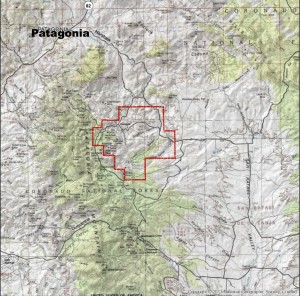
Assist PARA in protecting our precious and imperiled natural resources such as clean water and wildlife, and actively advocate for the preservation of those resources by opposing AZ Mining Inc / Wildcat Silver’s draft EA drilling exploration plan.
Deadline to comment is Monday, April 7, 2014. The Hermosa draft EA is available online at the Forest Service project webpage:http://www.fs.fed.us/nepa/nepa_project_exp.php?project=41158.

Hermosa Drilling Proposal Location
Include your name, postal address, title of the project (Hermosa Drilling Project) and signature (or verification of identity upon request.)
Comments may be submitted as follows:
Email: Electronic comments including attachments may be submitted by email in word (.doc), rich text format (.rtf), text (.txt), portable document format (.pdf), and hypertext markup language (.html) to: comments-southwestern-coronado@fs.fed.us with subject: Hermosa Drilling Project.
Facsimile: 520-388-8305, ATTN: Margie DeRose
U.S. Mail: Coronado National Forest, ATTN: Margie DeRose, 300 W. Congress St., Tucson, AZ 85701
Hand-delivery: 6th floor, 300 W. Congress St., Tucson, AZ 85701. Monday through Friday, 8 a.m. to 4:30 p.m., excluding Federal holidays.
Only individuals who submit comments about this proposed project during this public comment period will be eligible to file an objection.
AZ Mining Inc / Wildcat Silver’s Pre-Feasibility Study contains a wide range of information about the open pit mine they want to dig in the Patagonia Mountains. PARA and Earthworks are coordinating to analyze AZ Mining Inc / Wildcat Silver’s pre-feasibility study so that the community can fully understand the impacts of the proposed open pit mine.
Earthworks is a national non-profit organization based in Washington D.C. that is “dedicated to protecting communities and the environment from the impacts of irresponsible mineral and energy development while seeking sustainable solutions. Earthworks stands for clean water, healthy communities and corporate accountability.”
By teaming with Earthworks and commissioning this report, the dangers of mining in the Patagonia Mountains can no longer be dismissed as opinion, but will present a meaningful and credible analysis highlighting specific and anticipated impacts from the proposed AZ Mining Inc / Wildcat Silver open pit mine.
We are fortunate to have a group of amazing and committed community members and generous donors supporting our work that make everything we do for the Patagonia area possible.
Please consider a gift today to ensure that we have the scientific analyses necessary to actively challenge the Hermosa proposal and AZ Mining Inc / Wildcat Silver’s web of obfuscation. You may contribute securely online at: www.patagoniaalliance.org/donations. Also, please consider a recurring monthly contribution through PayPal.
Every single contribution makes a sizable difference in our organization and ultimately for the community of Patagonia. It is only because of the generous support from people like you that we can undertake this critical work. Thank you!
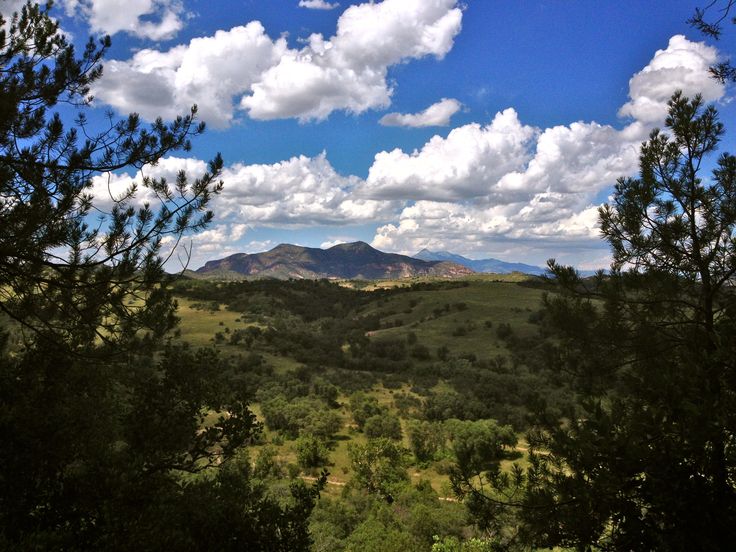
One site of Hermosa Mineral Drilling Proposal: Corral Canyon in the Patagonia Mountains.
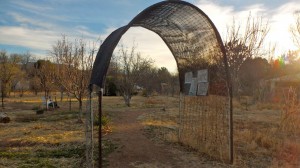
By Colin Treiber
Conveniently located at Fourth and Duquesne, the Patagonia Community Garden offers a resource to all aspiring or experienced gardeners. It is a great opportunity to connect directly to our food, our neighbors, and the earth. By participating in local food growing, we become closer to the land, the community, and life. Through growing our food we take a vested interest in our own health and the health of this planet.
The Patagonia Community Garden offers a variety of plots. Find the space that resonates with you and make it your own. In addition to the standard beds, we will have some raised beds, developed this year to assist those that may find it difficult to plant at ground level.
 The community space is convenient and affordable. Not only are you supported by the knowledge of many other gardeners, but you also have access to necessary tools, water, seeds, and seedlings to make your plot a beautiful and abundant garden.
The community space is convenient and affordable. Not only are you supported by the knowledge of many other gardeners, but you also have access to necessary tools, water, seeds, and seedlings to make your plot a beautiful and abundant garden.
The importance of the community garden—and the space it offers—is manifold. The dryness that has developed over the last several years has intensified recently. Poor agricultural conditions spread across the farmlands of the west. It seems inevitable that our nation’s food production will dwindle, and consumers will feel the burden of increasing prices.
Fortunately, the systems supporting our nation’s food industry are changing. Small, regionally adapted, and sustainable farms are gaining traction. Community gardens and home gardens are sprouting into prominence, and for good reason. As the Community Gardening Association puts it:
“Community gardening improves people’s quality of life by providing a catalyst for neighborhood and community development, stimulating social interaction, encouraging self-reliance, beautifying neighborhoods, producing nutritious food, reducing family food budgets, conserving resources and creating opportunities for recreation, exercise, therapy and education.”
It could be said that the community garden is a doorway to new growth and intimacy in our life. It is an opportunity to develop respect and understanding for all life that surrounds us and an occasion to bring greater abundance into our lives. Let us do the work, together, to nurture this abundance.
The Patagonia Community Garden rents plots at the low price of $5 per month. The garden has a variety of seedlings available for gardeners. They will begin to be available for sale in the garden greenhouse by late March. We look forward to turning the garden into a true community of gardeners and growers eager to share experience, ideas, stories, and food. Please call Martha at 520-394-2752 with any questions. See you in the garden!
Colin Treiber is PARA’s social media magician. Be sure to say ‘hi’ on Facebook or Twitter!

By Wendy Russell
The Patagonia Area Resource Alliance and Earthworks are working together to analyze AZ Mining Inc / Wildcat Silver’s Hermosa open pit mine plans so that our community can better understand its likely impacts. Earthworks is a national non-profit organization dedicated to protecting communities and the environment from the impacts of irresponsible mineral and energy development while seeking sustainable solutions. Earthworks stands for clean water, healthy communities and corporate accountability.
By reading reports that AZ Mining Inc / Wildcat Silver has recently released to investors which contain detailed information about its mining plans in the Patagonia Mountains, one can understand the purposes behind its current drilling exploration proposal of “drilling 24 geotechnical boreholes, 10 exploration boreholes and 12 hydrogeologic boreholes / monitoring wells, and excavating 16 test pits.” Spoiler alert: the sole purpose of the drilling proposal is to advance an open pit mine plan.
One purpose of the monitoring wells, as described in a January 2014 AZ Mining Inc /Wildcat Silver report, is to help “determine the quantity, location and pumping rates required to dewater the pit.” By the second year of mining,AZ Mining Inc / Wildcat Silver’s open pit would go below the water table, and water would be seeping into the pit. In order to mine,AZ Mining Inc / Wildcat Silver would have to continuously pump out this groundwater. The study says, “This creates a cone of depression around the pit allowing mining to take place.” What the report does not say is that this “cone of depression” will lower groundwater levels of the broader landscape. A rough calculation of groundwater pumping required by the mine would be 670 million gallons of water annually. To put this in perspective, the groundwater level for the town of Patagonia has already dropped nearly 18 feet since 2008, and the town uses approximately 42 million gallons per year. Wildcat’s mining would require 15 times that amount.
The geotechnical exploration that is slated to occur primarily in Corral Canyon and Goldbaum Canyon is also for AZ Mining Inc / Wildcat Silver’s open pit mine plans. Corral Canyon is described in AZ Mining Inc /Wildcat Silver’s report as “an optimal location for siting the TSF [Tailings Storage Facility]. Tailings typically contain dangerous chemicals, including arsenic, lead, mercury, and processing chemicals like acids and cyanide. AZ Mining Inc / Wildcat Silver notes that Corral Canyon is “at the top of the watershed.” It is also the top of the Patagonia Municipal Supply Watershed, the sole source of drinking water for the town of Patagonia and an additional 300 area wells.

Corral Canyon in the Patagonia Mountains, proposed site for AZ Mining Inc / Wildcat Silver’s mine tailings piles.
AZ Mining Inc /
Goldbaum Canyon is the planned location for AZ Mining Inc / Wildcat Silver’s Waste Rock Storage Facility. Waste rock is rock that does not contain desired minerals. It often contains iron, which can transform to produce acid run-off when exposed to air and water. This phenomenon is known as acid drainage. Acid drainage is irreversible and is already an ongoing issue from historic mines in the Patagonia Mountains.
The 10 exploration holes proposed in the current drilling plan, whose purpose is to prove the extent of the silver deposits, are essentially the same exploration holes AZ Mining Inc / Wildcat Silver proposed in 2011 but withdrew when PARA, Defenders of Wildlife, and Sky Island Alliance sued the Forest Service over its approval of Wildcat’s plans.
By reading AZ Mining Inc / Wildcat Silver’s reports to investors, it becomes clear that the only purpose of the Hermosa drilling proposal is to further develop an open pit mine plan. It is most certainly not a water study done for the benefit of the Town of Patagonia–a concocted assertion put forward by supporters of the mine. A peer-reviewed study of AZ Mining Inc / Wildcat Silver’s mine plan being prepared by PARA and Earthworks will provide the facts and detailed information on anticipated risks to our groundwater, the potential for acid drainage contamination, and heavy metals pollution, as well as the range of issues associated with air pollution, light and noise pollution.
By Wendy Russell
In January, the Forest Service (FS) was slated to issue a Categorical Exclusion (CE) decision for Regal’s exploratory mineral drilling proposal in Humboldt Canyon in the Patagonia Mountains. This would indicate that the FS considers their proposal to be “without significant environmental impacts.”
In the past, a CE decision would allow a company to proceed with their proposed project immediately. However, the FS now offers an administrative appeal process for projects given a CE Decision. Anyone who commented on Regal’s Sunnyside proposal during the initial scoping comment period is entitled to participate in the appeal process. Once the decision is issued, the FS will publish a notice in the Nogales International newspaper, which starts a 45-day window within which to file an appeal to the FS.
PARA plans to assist folks in submitting objections during the appeal process. We will post the workshop date in our Newsletter, Events Calendar, and on our social media sites. Jenny Neeley, former Conservation Policy Director & Legal Counsel for Sky Island Alliance, will be leading that workshop.
In an update from Coronado National Forest Sierra Vista District Ranger Mark Ruggiero, there’s been a delay in issuing the CE Decision for Regal Resources because the mining company is supposedly experiencing financial difficulties.
In another ongoing NEPA process in the Patagonia Mountains, the release of a Draft Environmental Assessment for AZ Mining Inc / Wildcat Silver’s Hermosa exploration proposal is also anticipated. The National Environmental Policy Act (NEPA) requires a “detailed statement” on the impacts of any proposed action that may “significantly affect the quality of the human environment.” Projects with anticipated environmental impacts get classified by NEPA as either requiring an “Environmental Assessment” or an “Environmental Impact Statement.” An Environmental Assessment (EA) is a brief analysis used to determine the significance of impacts resulting from a proposal. The EA is first released in draft form for public review and comment.
Coronado National Forest Sierra Vista District Ranger Mark Ruggiero issued a letter on December 18, 2013, announcing the anticipated Draft Environmental Assessment for the AZ Mining Inc (Wildcat Silver / Arizona Minerals) Hermosa Plan. Its release will trigger a 30-day public comment period before a final decision is issued. The letter also reported that in response to numerous comments received during the first scoping period, revision was made to the Hermosa Plan of Operation (Plan) “in order to reduce identified conflicts as to cultural resources.” The revised Plan is available on the Hermosa Drilling Project page on the Forest Service website: www.fs.fed.us/nepa/nepa _project_exp.php?project =41158. The changes are summarized in Appendix G.
If you have further questions about the Hermosa Plan, contact Margie B. DeRose, Geologist/Hermosa Project Manager, Coronado National Forest at (520) 388-8341 or mbderose@fs.fed.us.
Tell the Coronado National Forest that a full Environmental Impact Statement (EIS) is necessary when considering AZ Mining Inc (Wildcat Silver / Arizona Minerals) proposed Hermosa mineral drilling exploration project. Sign Petition here!
PARA is mobilizing community members to respond to the Hermosa Draft EA comment period. We will post the workshop date in our newsletter, Events Calendar, and on our social media sites. Jenny Neeley, former Conservation Policy Director & Legal Counsel for Sky Island Alliance, will be leading the workshop.
The Forest Service has released the Final Environmental Impact Statement (FEIS) for the proposed Rosemont Copper Mine Plan. In a new procedure for the Forest Service, an objection period is now available on the FEIS only for those parties who previously submitted scoping comments on Rosemont. The objection period started January 1 and is scheduled to end February 14.
Objections, including attachments, must be filed via mail, fax, email, hand-delivery, express delivery, or messenger service (Monday through Friday, 8:00 a.m. to 4:30 p.m., excluding holidays). Send to: Reviewing Officer, Southwest Region, 333 Broadway SE, Albuquerque, NM. 87102; by FAX to (520) 842-3173 or email to objections-southwestern-regional-office@fs.fed.us. For more information, contact Mindy Sue Vogel, Coronado National Forest, 300 W. Congress, Tucson, AZ, 520.388.8327, msvogel@fs.fed.us
Rosemont is now proposing a high volume of traffic through Patagonia. Rosemont’s FEIS now has added delivery routes for copper concentrate to Guaymas, Mexico. Highway 82 from Sonoita to Nogales is slated to be one of the delivery routes of copper concentrates from the proposed Rosemont mine. Trucks could be expected to make up to 56 round trips per day through Patagonia.
The Coronado National Forest (CNF) has prepared a Draft Land and Resource Management Plan, to update the current management plan, which was written in 1986. The public review period has already started, with deadline to comment on February 20, 2014.
UPDATE: The Forest Service has announced an extension of the public comment period. It has been extended an additional 14 days ending on March 6, 2014.
The Draft Forest Plan can be found on the Forest Service website: www.fs.usda.gov/detail/coronado/landmanagement/planning/?cid=fswdev7_018673. If you have questions or would like more information, please call the CNF office at 520-388-8300. Tell the receptionist you want to speak to someone about Plan Revision. You will be connected with one of the Plan Revision Core Team member.
Comments can be submitted via: Coronado Forest Plan Revision P.O. Box 1919 Sacramento, CA 95812, by fax (916) 456-6724 (Subject: Coronado National Forest, Plan Revision); or by email to CoronadoNF@fscom-ments.org (Subject: Coronado National Forest, Plan Revision).
Area conservation organizations have formed working partnerships in order to effect management recommendations to the new Forest Plan. The Coronado Planning Partnership (CPP) formed in 2006 in response to the Coronado National Forest initiating revision of its Forest Plan. The Partnership includes nearly 40 groups and landowners devoted to influencing and overseeing the new Forest Plan. Their mission includes promoting “the protection of wild species, their habitats, and ecological communities, as well as the processes that sustain them, on the Coronado National Forest.” The Partnership has released a report, State of the Coronado National Forest: An Assessment and Recommendations for the 21st Century, that they encourage the public to use to formulate their own comments on the Draft Forest Plan. It can be found on their website: www.skyislandaction.org/state_of_coronado.html.
CPP member, the Arizona Wilderness Coalition, is holding two meeting to encourage folks to comment on the Draft Forest Plan on February 6, 5-7pm, at the Martha Cooper Library 1337 N. Catalina Ave, Tucson and February 13, 6-8pm, at REI 160 W Wetmore Road, Tucson. Please check the CPP website for additional information: www.skyislandaction.org/cpp.html
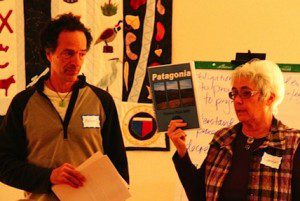
It’s hard to believe that the end of the year is approaching! When 2013 began your friends, neighbors, and colleagues here at the Patagonia Area Resource Alliance (PARA) were gearing up for a busy year promoting the incredible beauty, community and natural heritage of your Town of Patagonia and the Patagonia Mountains. Little did we know what a whirlwind this year would be! The past eleven months have seemingly sped by while we have been advocating to protect this amazing place that we all treasure from the multiple threats that exploratory drilling and mining pose to our small community.
PARA was formed in 2011 to educate and engage the community about the risks and realities of mining, to promote local sustainable economies like ecotourism, to better understand our precious and imperiled natural resources such as clean water and wildlife, and to actively advocate for the protection of those resources in concert with Patagonia’s distinct and serene rural way of life.
You have helped us along the way this year! You have volunteered, come to public meetings, wrote letters to elected and appointed officials; you have taken a class to learn more about the wildlife in our midst and asked poignant questions about the future of our community. Together, we have contributed over 5000 volunteer hours already in 2013!
It has been an amazing and transforming year for PARA, but we have so much more to do! PARA runs on a shoestring budget with the human power of an almost entirely volunteer workforce and just one part-time, coordinator. We’d like to do so much more! Please consider making a donation to PARA this year to support and grow this critical work in our community.
Educating the Community, Empowering Ourselves
With a grant awarded from Patagonia® Inc, PARA and Sky Island Alliance (SIA) co-hosted an Advocacy workshop for area residents with national expert Dinah Bear on the National Environmental Policy Act (NEPA). We put on two additional NEPA environmental impact scoping comment workshops on mining proposals and held four more letter writing sessions. The PARA Board also participated in our own workshops with SIA Executive Director, Melanie Emerson. Read more…
Documenting Patagonia’s Natural History
We hosted a BioBlitz in the Patagonia Mountains with Dr. Tom Van Devender of SIA and scientists from all over the Southwest. 418 different species of plants and animals were documented in one weekend–including a new American record of the Willowleaf Oak (Quercus viminea). Results are being used to protect species and habitats imperiled by mining and drilling proposals and can be viewed online at www.madrean.org. Read more…
Advocating for Protection Through Tireless Outreach
PARA steadfastly engages elected officials and national organizations regarding the perils that Patagonia faces with proposed mining. This year we conducted tours of proposed mine sites to representatives from the U.S. Senate, Defenders of Wildlife, EARTHWORKS, TrekWest and the media. We remain dogged in our outreach to get and keep attention focused here. Read more…
Ensuring Agencies’ Due Diligence
We successfully made the case that the NEPA scoping period for Regal Resources mineral drilling proposal in Humboldt Canyon be re-opened. PARA advocated and reasoned with the District Ranger of the US Forest Service that NEPA decisions should be made using current rather than outdated information. He concurred and ultimately gave us all two additional years to prepare data for more comprehensive scoping comments that can accurately articulate the broadest range of potential impacts. Read more…
To learn more about our 2013 accomplishments and efforts, please take a look at PARA’s “Report to the Community” available on our website at: www.patagoniaalliance.org/our-activities-outreach/
Unceasing Protection of the Patagonia Mountains.
With continued legal assistance from Defenders of Wildlife, PARA strives to hold mining companies, the US Forest Service and all agencies accountable to follow the laws and regulations designed to protect our water, air, surrounding ecosystems and communities. We are positioned to respond to future public scoping notices for exploratory mining proposals scheduled for the Patagonia Mountains.
Sustaining Wildlife Data Documentation and Collaborations
Citizen scientists from the Town of Patagonia continue wildlife monitoring efforts in the Patagonia Mountains focusing on areas immediately at risk by proposed mining activities. Data gathered is used to fight mining proposals through species lists, presence of vulnerable species and habitat analysis. Additional collaborations are ongoing with Defenders of Wildlife, EARTHWORKS, Sky Island Alliance and others to ensure this data is applied to advocacy efforts in the most effective ways.
Increasing Our Outreach for 2014
PARA is strategizing to expand community education activities to grow our base of support and empower concerned residents with potential actions to keep mining out of the Patagonia Mountains. We recognize the need to establish sustainable funding to maintain core functions and seek to expand funding sources. Receiving our own 501(c)(3) non-profit status was just the first step. With additional staff funding in the 2014 budget, we plan to add members to our team to continue to expand our outreach beyond our community boundaries. Our 2013 Financial Report is also available online: www.patagoniaalliance.org/our-activities-outreach/
For A Thriving Community in 2014 and beyond
PARA recognizes that the health and economic prosperity of our community are deeply connected to the wellbeing of the Patagonia Mountains and the Harshaw/Sonoita Creek watershed. They are the source of our drinking water, clean air and the centerpiece for the tourism that drives our local economy.
There are many needs in our community and many compelling requests for support. We believe one of the most fundamental is protecting our drinking water and our community from the well-known detrimental effects of open pit mining. To that end, PARA is seeking to raise $19,000 by the end of 2013 to support the several ongoing and new initiatives outlined above as we move into 2014. We are fortunate to have a group of amazingly committed community members and generous donors supporting our work, but we are looking to broaden the base of support to ensure not only financial sustainability, but also the ability to impact local, regional and national decision-making on our own behalf. That’s where you come in. The work necessary to make this vision of 2014 a reality is possible only because of your time and your financial support. Please make a gift today.
Please donate to PARA securely online at: www.patagoniaalliance.org/donations/
Every single contribution makes a sizable difference to our organization and ultimately for our community. It is only because of the generous support from people like you that we can undertake this critical work. Thank you!
Your PARA Board and Coordinator
Carolyn Shafer, Cliff Hirsch, Gooch Goodwin, Joseph Nitsche, Katie Flemming-Ballard, Lee Rogers, Michael Stabile and Wendy Russell
By Jenny Neeley, Conservation Policy Director & Legal Counsel of Sky Island Alliance
The National Environmental Policy Act (NEPA) requires all federal agencies to prepare a “detailed statement” on the impacts of any proposed action that may “significantly affect the quality of the human environment.”¹ This “detailed statement” can take one of two forms:
Federal agencies are required to go through a public “scoping process” in order to determine the scope of issues that should be addressed in an EA or EIS. Scoping also helps the agency determine the likely significance of an action’s impacts, and whether an EA or an EIS will be required.
The scoping period is the best time to identify all the issues and resources that the agency must consider when preparing an EA or EIS, as well as the potential impacts the proposed action may have on those resources.
This includes all the resources and values that are likely to be impacted by the proposed action, including:
The scoping period is also the best time to identify all the potential impacts that are likely to result from the proposed action. The potential impacts will vary depending on the specific activity being proposed, and can include ecological, aesthetic, historic, cultural, economic, social, and health related impacts. When assessing potential impacts, the agency must look at:
REMEMBER: You don’t have to do the analysis for the agency. At the scoping stage, you just need to identify the issues and potential impacts that must be analyzed. You should also submit any research or supporting documentation that is relevant to assessing the significance of the project’s potential impacts. The agency is obligated to consider this material when drafting the EA or EIS.
———————————–
1 National Environmental Policy Act (NEPA), 42 USC § 4332(C) (1982).
2 Council for Environmental Quality, NEPA Implementing Regulations, 40 CFR § 1508.8 (2010).


|
||||||||||||||||
|
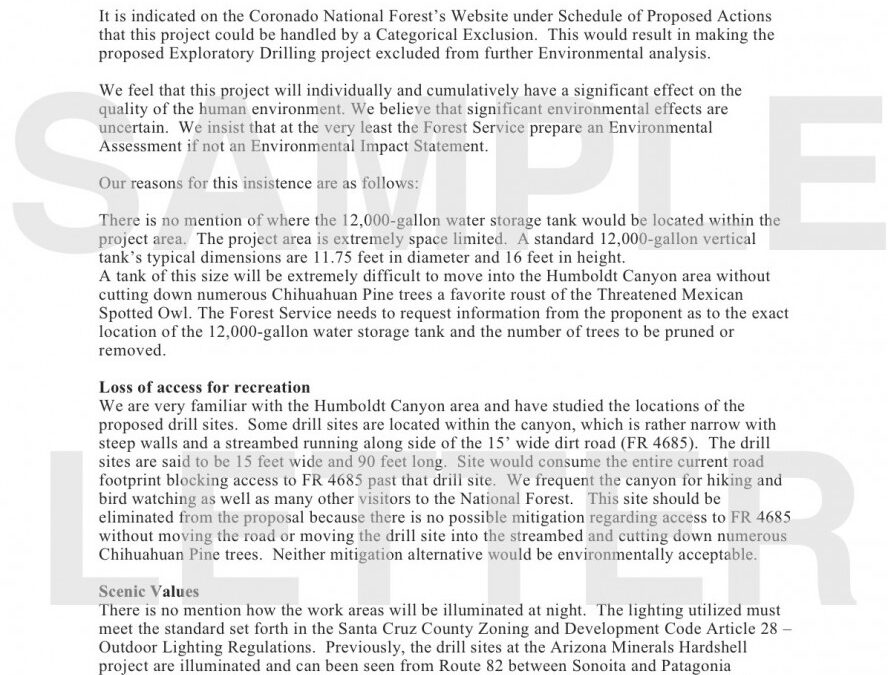
By Jenny Neeley, Conservation Policy Director & Legal Counsel of Sky Island Alliance
The National Environmental Policy Act (NEPA) requires federal agencies to go through a public “scoping process” in order to determining the scope of issues to be addressed in an environmental assessment (EA) or environmental impact statement (EIS). To start the process, the agency must issue a Notice of Intent and invite public input on the scope of issues to be examined. The US Forest Service is required to go through a public scoping process for all proposed actions, including those that the Forest proposes to categorically exclude from NEPA analysis.
When agencies give proposed projects a “categorical exclusion” from NEPA, the agency is not required to take a close look at the environmental impacts of the project. Below is more information on how the public can engage in the scoping process and make the case that the project should not be categorically excluded, but should instead be subject to an EA or an EIS under NEPA.
A categorical exclusion (referred to as ‘CE’ or ‘Cat Ex’) is a category of actions established by each individual agency that are exempted from the NEPA requirements to prepare an EA or EIS because they are considered to not have a significant effect on the human environment, either individually or cumulatively.¹ A proposed action may be categorically excluded from preparing an EIS or EA only if it fits into one of these categories and “if there are no extraordinary circumstances related to the proposed action.”
There are four steps to writing effective comments that challenge the use of categorical exclusions:
1. Check the mining plan to make sure the proposed action fits into the categorical exclusion for mineral exploration activities: “Short-term (1 year or less) mineral, energy, or geophysical investigations and their incidental support activities that may require cross-country travel by vehicles and equipment, construction of less than 1 mile of low standard road, or use and minor repair of existing roads.”² If the proposed action does not meet these parameters, then it cannot be excluded from NEPA.
2. Determine whether there are any “extraordinary circumstances” that relate to this proposed action: Resource conditions that are considered in determining whether extraordinary circumstances exist are:
3. If one or more of the above resource conditions exist in the project area, you must demonstrate that:
4. Show that the impacts of all past, present, and reasonably foreseeable future actions in the project area raise uncertainty about the significance of the “cumulative impacts” of this project. The Forest is required to examine the impacts of all past, present, and reasonably foreseeable future actions in the project area, regardless of what agency or entity is undertaking those actions, and determine the potential for cumulative impacts. When a project is proposed to receive a cat ex, you can make the case for preparing an EA by raising uncertainty over the significance of these effects.
After making the case that a categorical exclusion is inappropriate, don’t forget to also identify the scope of issues you think should be addressed in the EA you are asking the agency to prepare. It is important submit comments identifying the full range of resources and issues that may be impacted by the proposed action. These resources and issues generally include:
Remember: you don’t have to do the analysis for them. At the scoping stage, you just need to identify the issues they must analyze. You should also submit any research or supporting documentation that is relevant to assessing the impacts of this project on the identified resources. The agency is obligated to consider this material in its assessment.
Other online resources:
USFS NEPA Handbook: Categorical Exclusions
[Date]
[Address]
[Re: Project name]
Open your letter with something personal describing why you care about this place: “I am a resident of Patagonia;” “I often visit the Patagonia Mountains for recreation/employment/tourism;” “I own a property in the area;” etc.
This project should not qualify for a categorical exclusion from NEPA. a) Extraordinary circumstances in the project area raise uncertainty about the project’s impacts; and b) The potential for cumulative impacts raise uncertainty about the project’s impacts. (See above for more information on how to make this argument effectively.)
The agency [Forest Service] should prepare an environmental assessment to analyze the impacts of this project on all the resources in the project area. (See above for sample list of resources and issues to identify.)
August 15, 2013 public comment deadline for Regal Resources Sunnyside mining exploration proposal.
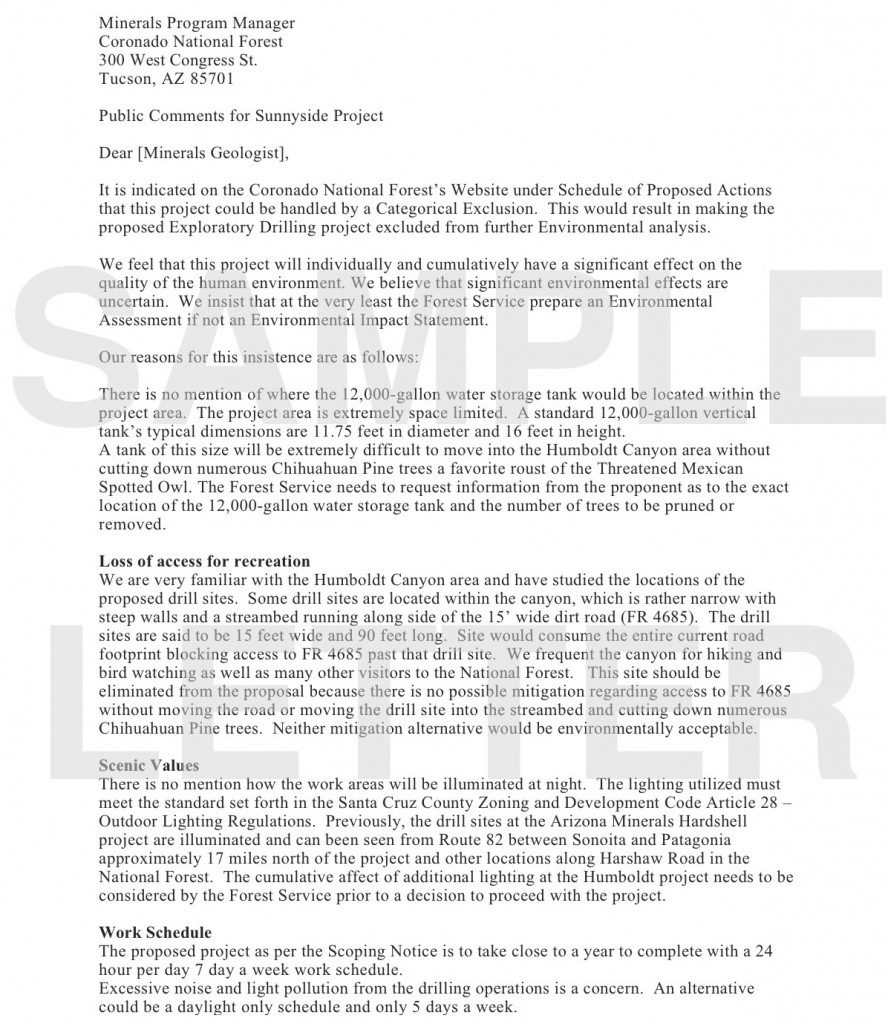
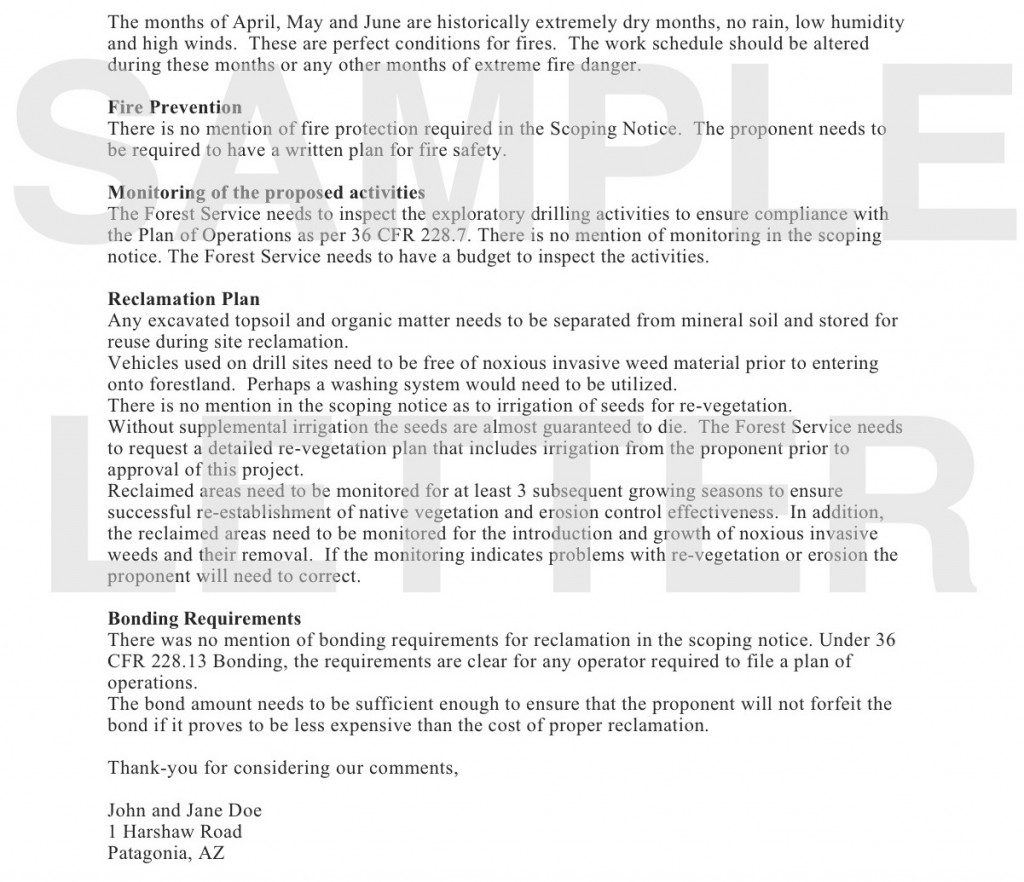
———————-
1. Council for Environmental Quality (CEQ) Regulations for Implementing the National Environmental Policy Act (40 CFR 1508.4). Available at nepa.gov/ceq_regulations/regulations.html
2. USFS NEPA Handbook; FSH 1909.15; 36 CFR 220.6(e)(8)). Available online at http://www.patagoniaalliance.org/wp-content/uploads/2013/08/US-Forest-Service-NEPA-Handbook_Categorical-Exclusion-regs.pdf
3. USFS NEPA Handbook, FSH 1909.15; 36 CFR 220.6(b). Available online at http://www.patagoniaalliance.org/wp-content/uploads/2013/08/US-Forest-Service-NEPA-Handbook_Categorical-Exclusion-regs.pdf
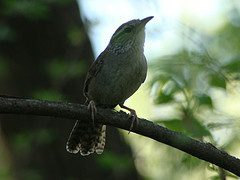

Sinaloa Wren ©Matthew C. Brown
The Patagonia Mountains are full of biological diversity. The mountains cross the border into Mexico, creating a virtual bridge for plant and animal species to the south. Consequently, we have many species from Mexico that are only found in the United States in Patagonia. Birders already know that the Sinaloa Wren can be seen in the States in Patagonia, Arizona. The Patagonia Mountains also provide important wildlife corridors and habitat for large mammals such as jaguars, ocelots, bears and mountain lions. To catalog and substantiate this biodiversity, we hosted Patagonia BioBlitz Days.

BioBlitz Activities with Arizona Public Media ©Glen E Goodwin
What’s a BioBlitz? It’s an intense biological survey conducted in a short amount of time with the goal to record as many specimens as possible. We hosted a BioBlitz for the Patagonia Mountains with Sky Island Alliance and scientists from all over the Southwest on April 26-28, 2013. A crew from Arizona Public Media was on hand on Friday to record some of the action. See “Nature by the Numbers” by Tony Paniagua on Arizona Illustrated Nature.
The data collected from the BioBlitz is being posted onto the Sky Island Alliance database called the Madrean Archipelago Biodiversity Assessment (MABA) Project. The project is managed by Dr. Tom Van Devender who brings a wealth of knowledge about the sky islands from a lifetime of research on both sides of the border. Preliminary plant results from the Patagonia BioBlitz can be found here. We’ll make further announcements as more data is interpreted and posted to the MABA website.
Read the Final Report: Patagonia BioBlitz
Partial funding for the Patagonia BioBlitz was received by a grant from Patagonia®. We plan to use the Patagonia BioBlitz findings to block new mining activity in the Patagonia Mountains.

With permission, we’ve re-posted John Davis’s Blog from the Wildland’s Network TrekWest Journey.
With Patagonia Area Resource Alliance, Sky Island Alliance and Defenders of Wildlife, Early March
“A veteran fence-cutter myself (always legally, of course, removing old barbed wire from various wild way lands where I work back East), I could almost feel the sense of liberation as Sergio described taking the fence out of a wildlife corridor…”
Lobo stood with us symbolically atop American Peak as we gazed worriedly down on the proposed site of the Wildcat Silver Mine (below right). Lobo is a promise, an artistic expression of hope crafted by a Zuni sculptor. This small figurine and others (including jaguar and ocelot, which are also both native to southern Arizona but jeopardized by roads and the border wall) we bear with us on this wild walk-about. The proposed Wildcat Silver Mine is a curse visited upon the good wildlife and people of the Patagonia Mountains and surrounds. If the Wildcat Silver Mine plans are approved, the Southwest will lose a critical wildlife corridor, vibrant waters, and scenery to live for.
Patagonia Area Resource Alliance (PARA) and kindred groups aim to prevent this theft. Together with Defenders of Wildlife, Sky Island Alliance, and others, PARA is organizing local and state residents to oppose this mine. Please help them.
Our day was not all about threats and alarms, though. PARA leaders showed me Madrean oak/pine woodlands primordial in their beauty, and talked with me also about their work on sustainability. This work includes pollinator advocacy led by naturalist and writer Gary Paul Nabhan, with whom I serve on the Board of Directors of Wild Farm Alliance http://wildfarmalliance.org. As Gary’s research has shown, southern Arizona is a continental leader in diversity of bees, ants, bats, hummingbirds, and other animal groups that include pollinators critical to both native and cultivated plants. The great diversity of pollinators in the Sky Islands owes to its topographic, geologic, and vegetative diversity.
So does the Madrean Archipelago’s exceptional diversity in mammals, about which Sergio Avila of Sky Island Alliance told us as we strode the Patagonias. From atop American Peak, Sergio pointed out how these mountains, modest in stature but immense in diversity, reach south into Mexico and how parallel ranges also provide key corridors for animals like jaguars and ocelots. Sergio noted that the Sky Islands is one of the few areas north of the tropics where one can find four native cats: bobcat, cougar, ocelot, and jaguar, all of which are wide-ranging and need big wild interconnected habitats.
Sergio also pointed to the border wall, cutting across the San Rafael Valley and into the mountains, threatening to sever the connections that keep these mountains so rich. Some of the rugged areas along the border thus far have been spared the building of impassable fencing; and it should be an international conservation priority to keep these wildlife corridors wall-free. Sergio had a bit of heartening news for all of us: He and other Sky Island Alliance folks had recently spent some time, at the request of the Bureau of Land Management, removing the barbed wire along the US/Mexico border where agencies deemed a simple vehicle barrier to be enough of a deterrent to drug traffickers. A veteran fence-cutter myself (always legally, of course, removing old barbed wire from various wildway lands where I work back East), I could almost feel the sense of liberation as Sergio described taking the fence out of a wildlife corridor.
TrekWest Action: Please don’t forget, to help fight these threats, you can go to trekwest.org and sign the petition to Say YES to protecting our Fast-Disappearing Wildlife Habitat Corridors, which we will deliver to decision-makers who can speed up this important conservation need. Also support the worthy organizations featured in this blog!
For the Wild,
John
Your kind consideration of a DONATION– all to help TrekWest inspire as many people as possible to support wildlife corridors and to keep up with basic supplies and equipment — is much appreciated.
Also, thank you SPONSORS!

By Dave Ellis
March 18, 2013
Two news items of interest appeared on March 4. First, the announcement by Arizona Mining Inc (Wildcat Silver), “Wildcat Silver to Acquire Riva Gold”. Second, a new report by business and financial advisers Grant Thornton UK LLP that has found that “Junior Mining Companies [like Arizona Mining Inc / Wildcat Silver] are facing significant shortfalls in working capital, posing a major concern to future growth prospects.” Read full article: Money worries weigh on juniors at PDAC
With a little internet research, it is clear that the two items are closely related. First, the Arizona Mining Inc / Wildcat Silver announcement has lots of qualifiers. So, the reality is that Arizona Mining Inc / WS and Riva Gold have simply entered into a Letter of Agreement providing for the acquisition by Arizona Mining Inc / Wildcat Silver of all Riva shares at 4.7 Riva for 1 Arizona Mining Inc / WS share. Riva has C$8.1 million cash and no mineral properties or activities. So it ain’t a done deal. “The proposed acquisition remains subject to, among other things, “– the negotiation and execution of a definitive agreement and applicable shareholder and regulatory approvals.”
Further, Riva agreed to provide a C$1 million loan to Arizona Mining Inc / WS at prime + 4% maturing on 12/31/2013. So WS gets some cash to drill some more holes on or around the Hermosa property. Between the lines, this means Arizona Mining Inc / Wildcat Silver has not been able to attract investor interest and, in desperation, has to accept limited, expensive financing for further exploratory drilling.
Second, Arizona Mining Inc / WS is not alone in failing to attract precious metals investors (suckers?) There are about 1600 Junior mining companies around the world. Neither Arizona Mining Inc / WS nor Riva are even listed as Juniors! The Grant Thornton report states that “Low cash balances, coupled with broader pressures around regulatory risks and rising operating costs, have put some Junior miners at a disadvantage in the capital markets and undoubtedly some of the poorly managed entities will go bust in the near future.” (We can only hope!)
The Back Story
It is helpful to step back and look at the money game in relationship to Gold & Silver. From Wikipedia, we learn that the silver market was 490 million oz (Moz) industrial, 167 Moz jewelry, and 101 Moz investment in 2010. Industrial use transitioned gradually from pre-digital camera photography to RoHS lead-free electronic solder and Photovoltaic solar panels over a 10 year period. The jewelry market is even more stable. Thus, the “real” uses of silver metal evolve slowly. In contrast, the market for silver & gold investment changes as fast as money moves around. Like — Fast! As with the housing market from 2002 to 2008, the precious metals market is currently experiencing an investment bubble.
The graphs clearly show both the Gold and Silver “bubbles” now in their terminal downward phase.

Silver Prices
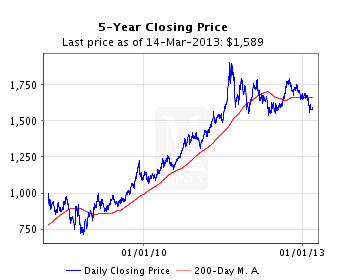
Gold Prices
Check out: http://www.google.com/finance?q=TSE%3AWS&ei=TF5DUZnFENL0rAGheQ
You will see that the price of WS stock mirrors http://www.monex.com/prods/silver_chart.html
PARA’s activism forces Arizona Mining Inc / WS to spend precious $ to move forward. So our efforts make a difference!
Notes: Silver ($45/$10 = 4.5) more volatile than Gold ($1800/$750 = 2.4). Both fast investment bubbles are due to “flight-to-safety in uncertain times”. Euro economies are stabilizing. Therefore, waning gold-silver investment goes down, so junior silver miners are struggling – duuuh!

The Patagonia Area Resource Alliance is working to stop industrial mining in the Patagonia Mountains. We are very concerned about protecting and preserving the town’s water supply. Part of our mission also includes promoting the local tourism-based economy to our surrounding public lands and parks. The interesting thing that I’ve discovered while working for PARA is that our mission overlaps or complements the mission of many other organizations both local and national. Given that we’re on the Mexican border, I can say international organizations too! One of those organizations that complements our work is Wildlands Network.
John Davis with Wildlands Network is hiking the Western Wildway of the continent from Mexico to Alaska to promote awareness of the need for wildlife corridors. The Western Wildway is a 6,000-mile-long wildlife corridor that includes Mexico, the United States and Canada. According to their website, “protecting the Western Wildway represents North America’s best chance to ensure the survival of many threatened keystone species that require long-distance movement pathways, including grizzly bear, lynx, mountain lion, wolves, jaguars, and ocelots — all faced with growing pressure from development-based habitat fragmentation and climate disruption.” Learn more at www.trekwest.org
John Davis recently traveled through Patagonia, Arizona. PARA got the opportunity to show him the area in the Patagonia Mountains that is being threatened by Wildcat Silver’s proposed open pit mine. Accompanied by Matt Clark from the Southwest office of Defenders of Wildlife and Sergio Avila from Sky Island Alliance, we climbed American Peak in the Patagonia Mountains. We discussed how the wildlife corridor for jaguars, ocelots, bears and mountain lions through the Patagonia Mountains would essentially be blocked by the proposed Wildcat Silver mine. At the top of the peak, we could see into Mexico. The Patagonia Mountains are only one of two sky island mountain ranges that cross the border into Mexico. Sergio Avila quoted a study that showed that our bear population in the Patagonias is more closely related to bears in Mexico than they are in the nearby Santa Rita Mountains. The bird’s-eye view from the top further demonstrated the importance of the Patagonia Mountains as a wildlife corridor and the vast area of the mountains that would be impacted by Wildcat Silver’s proposed open pit mine, tailings piles, waste rock, tailings ponds and processing plants. Open pit mining operations and wildlife corridors cannot coexist.

Sergio Avila with John Davis on American Peak.
Photo ©Glen E Goodwin
We were thankful for the opportunity to bring our mission to stop mining in the Patagonia Mountains to the attention of an international organization with a complementary mission to keep North American wildlife corridors open. There are so many good reasons to keep open pit mining out of the Patagonia Mountains. Keeping vital wildlife corridors open is another one.
Wendy Russell

The Super Citizen Advocacy Workshop hosted by the Patagonia Area Resource Alliance and Sky Island Alliance was a great success! We had over 30 folks come spend a beautiful Saturday afternoon with us in Cady Hall
The afternoon started out with Wendy Russell discussing the 5 mining projects with applications for mining exploration in the Patagonia Mountains. Three of the projects are situated at the head of the watershed for the town of Patagonia. Read more here: http://www.patagoniaalliance.org/patagonia-mining-proposals/

Melanie Emerson, Executive Director of Sky Island Alliance
Next up was Melanie Emerson, Executive Director with Sky Island Alliance with an exercise for the attendees of “Why are YOU here.” Answers ranged from protecting the mountains, saving the watershed, preserving dark skies, preserving peace and quiet to finding out how to help PARA stop the mines.
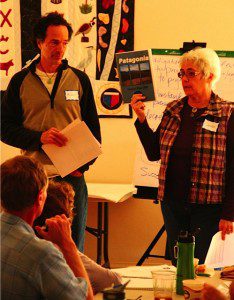
PARA Board Members Michael Stabile and Carolyn Shafer
Michael Stabile and Carolyn Shafer gave a presentation on current Patagonia directives that may be related to mining. Michael cited the new Vehicle Weight Ordinance and Watershed Policy which both help to protect the town from the extreme traffic and water usage that comes with mining. Carolyn Shafer discussed the Town Plan. The plan is very explicit when it comes to mining activity. It states as one of its goals, “Discourage mining and other activities that damage or detract from Patagonia’s environmental and scenic quality.” Read the Town Plan here.
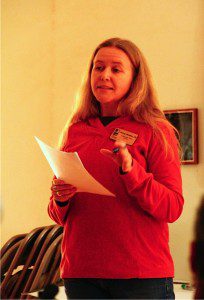
Jenny Neeley with SIA
Jenny Neeley Conservation Policy Director and Legal Counsel for Sky Island Alliance gave an overview of State and Federal Laws that affect mining on public lands. Some more familiar federal laws are the 1872 Mining Law, Clean Water Act and the Clean Air Act.
For an overview of the National Environmental Policy Act, we were very fortunate to have an expert, Dinah Bear. She had the unenviable task of condensing her 5 day course into a 30 minute discussion on NEPA. We’re all grateful for the copies of The Citizen’s Guide to NEPA that she brought. She also reminded us that you don’t have to be an expert to comment on these mining proposals.
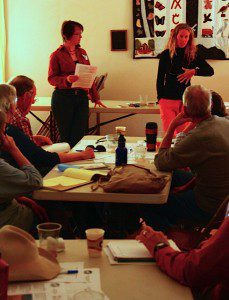
Wendy Russell & Kathi Noaker with PARA
Kathi Noaker and Wendy Russell helped to wrap up the afternoon with all of the different ways participants can spread the message about the threats to the town of Patagonia’s water, natural resources and community. We ended with many of the participants coming forward to sign on to help the PARA mission of education and outreach regarding the potential threats from mining in the Patagonia Mountains. Our super citizens of the town of Patagonia were amazing!
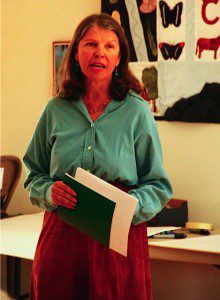
NEPA expert Dinah Bear
Thank you everyone! Special thanks to Dinah Bear, Jenny Neeley, Melanie Emerson and Patagonia® for helping to make it all possible!
Photos by Glen E Goodwin ©2013
For another view on the workshop, read “Save the Scenic Patagonia Mountains” blog by owner of the local B&B, A Room with a View. Thanks Sonia! Blog link: http://bit.ly/VKhUqu
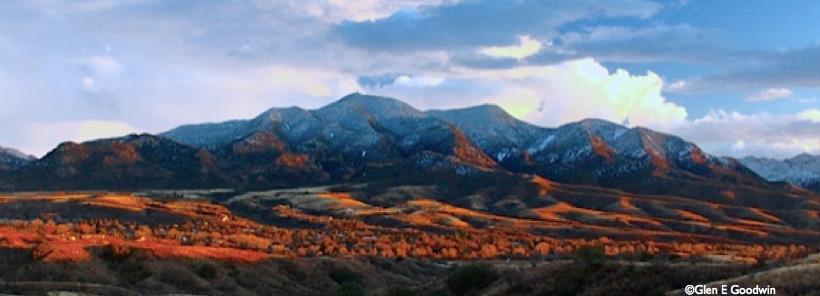
Visit the small town of Patagonia near Arizona’s southern border and the first thing you’ll notice is Red Mountain, the most prominent peak of the Patagonia Mountain range. Red Mountain and the rest of the mountain range contain an amazing array of native plant and wildlife species and even more extraordinary landscapes. There’s more biodiversity here than in Yellowstone National Park! The town of Patagonia, nestled at the base of the mountains, is the perfect launching off point for a wide variety of outdoor recreational activities including hiking the Arizona Trail, mountain biking, and world-class bird-watching. The community relies on this eco-tourism as well as the tourists that come to town just to enjoy our locally-owned restaurants, galleries and shops.
Unfortunately, our community and our mountains are immediately threatened by several hard rock mining proposals that would have severe and permanent impacts to this important Sky Island mountain range and the town of Patagonia. The mining claims encompass most of the Patagonia Mountains, including Red Mountain and the Arizona Trail. They even go right up to the southern edge of town. These mining proposals would destroy valuable wildlife habitat and would cut critical wildlife migration corridors. The mining activities would use vast quantities of water. We fear that they would lower the water table, reduce the water available to the town and even dry up private wells resulting in dire impacts to the vegetation, wildlife and townspeople.
In response to these threats, the Patagonia Area Resource Alliance and the community of Patagonia is working with Sky Island Alliance to advocate for the watersheds and natural and cultural resources of the Patagonia Mountains. Through a grant awarded from the Patagonia® Clothing Company, PARA and SIA are organizing training workshops to encourage Patagonia area residents to identify and collect information that highlights the extraordinary biological richness of our mountains. We will use that information to effectively advocate for the protection of this cherished mountain range.
SIA is lending us its expertise in many ways, including training Patagonia-area volunteers to play a key role in inventorying and documenting mammals, birds, bats, plants and more. SIA and PARA will also team with regional experts and other partners to conduct springs assessments, unobtrusive wildlife monitoring, and road inventories for a better understanding of our area’s resources. To utilize this information as effectively as possible, PARA will work closely with SIA throughout this project to launch a community-engaged and science-based advocacy campaign. This campaign will empower and build capacity within our community to promote the protection of the Patagonia area and halt current mining proposals.
These efforts will enable the community to effectively respond to the numerous exploratory drilling and mining proposals slated for this fragile area. It will also ensure that we are well-positioned to repel any future proposals by promoting the protection of this special place and the plants, animals and people who call Patagonia home.
The Patagonia community, PARA and SIA are gearing up to make a difference! With support from Patagonia® Inc, we will protect and preserve our exceptional Patagonia Mountains, the home to diverse wildlife and plant species, extraordinary landscapes and our community of amazing people.
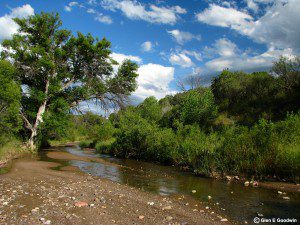
 With the Summer Rain season in full swing, it’s easy to forget that we live in the desert. It’s also easy to forget that we are in a long-term drought. There have been two recent stories in the news about our strained water resources. Both stories discuss water flow in nearby Cienega Creek. KVOA offers NASA images capture Tucson – then and now. The Arizona Daily Star has an article called Cienega Creek, other S. AZ. streams, increasingly dry.
With the Summer Rain season in full swing, it’s easy to forget that we live in the desert. It’s also easy to forget that we are in a long-term drought. There have been two recent stories in the news about our strained water resources. Both stories discuss water flow in nearby Cienega Creek. KVOA offers NASA images capture Tucson – then and now. The Arizona Daily Star has an article called Cienega Creek, other S. AZ. streams, increasingly dry.
The drought raises questions. The biggest one is how in the world can we support mining in the Santa Rita and Patagonia Mountains given the huge amounts of water they consume? Rosemont’s supposed solution is using CAP water to recharge the aquifer. Whether it can be done and whether it will help is debatable. Regardless, Rosemont Copper can pump all the groundwater they want without the CAP recharge.
There are four other mining companies doing mineral explorations in the Patagonia Mountains. Arizona Mining Inc (Wildcat Silver), the one furthest along, estimated that their planned open pit mine would consume roughly 700,000 gallons of water per day. Per day! For comparison, the maximum pumping capacity of the Town of Patagonia’s well water is 110,000 gallons per day. Don’t forget the 3 other international mining companies that want to mine in the Patagonia Mountains. Using the figure of 700,000 gallons of water per day per mine results in 2.8 million gallons of water used per day. Big numbers need perspective.
Because all water sites seem to deal in acre feet, let’s do comparisons in those figures. 2.8 million gallons equals 8.6 acre feet. Estimated water usage from four mines per year using Arizona Mining Inc’s (Wildcat Silver) numbers comes out to 3,139 acre feet. The Santa Cruz Active Management Municipal Areas which includes Nogales, Rio Rico, Tubac, Arivaca, uses 7800 acre feet of water per year. That does not include Patagonia, Sonoita or Elgin. Mining in the Patagonia Mountains could potentially use almost half of all the water used annually in the most populated cities in Santa Cruz County.
Do we even have that much water? Is this drought the new normal?
Sources:
An Investigation of Energy Use, Water Supply and Wastewater Treatment at Patagonia, Arizona
Dear Ms. Bush,
The Patagonia Area Resource Alliance was horribly disappointed with your editorial for Tucson KOLD News, “Time to end fight, start mining”.
We don’t consider actions of the opposition to the proposed Rosemont Mine as fighting. This mine would have a permanent impact on the area’s water supply, ecosystem, landscape and residents. We, the public, are entitled to a thorough analysis of the potential impacts of the proposed mine as accorded to us by the National Environmental Policy Act. When governing agencies fail to follow the rules as dictated by NEPA, lawsuits are often the only tool available to get compliance. Public lands belong to everyone, and we have a legal right to a transparent and thorough review of projects proposed on our public land. Don’t deny us our due process.
Arizona was traditionally a mining state, but mining has been replaced by the tourism, aerospace, and micro-electronics industries as our top revenue producers. Also consider that the revenue generated by mining is closely followed by that generated through agriculture/food production. Mining is no longer the primary driving economic force of Arizona. The Arizona Office of Tourism commissioned a ten year study that showed total direct travel spending in Arizona in 2008 was $18.5 billion with $1.4 billion in state and local tax revenues and $1.2 billion in federal tax revenues. These revenues are most important to rural areas like Sonoita. Can we afford to jeopardize our largest economic driver and greatest source of tax revenue?
Also note that a study commissioned by the Western Governors’ Association showed that outdoor recreation is a $646 billion national industry and in the Western States, it’s a $256 billion industry. Why not promote outdoor recreation in the Santa Rita Mountains? It’s sustainable; compatible with the current ranching and farming economy; and far less harmful to the water supply and ecology.
Arizona currently has enough operating copper mines to meet demand. These mines currently have hundreds of unfilled job openings implying that they are not even operating at full production. If current mines are unable to find sufficient workforce in Arizona, where is Rosemont Copper going to get their workers? The jobs they promise will have to be filled by an imported workforce. How does that benefit the unemployment rate in Arizona?
The Rosemont Mine has a projected life-span of approximately 20 years and will result in permanent damage to the Rosemont Valley and surrounding ecosystem. We need visionaries willing to look at the bigger picture and willing to move forward with what is going to benefit the most people for the longest period of time. The proposed Rosemont Mine does not fit that bill. Pushing it forward for the sake of short-term jobs denies the area of the much greater potential economic benefits of promoting industries such as ranching, food & wine production, outdoor recreation and tourism. We ask that you reconsider your position and promote a more sustainable and beneficial economic future for all Arizonans.
Sincerely,
Wendy Russell
Patagonia Area Resource Alliance
If you’d like to record a rebuttal to the KOLD editorial, e-mail Debbie Bush at dbush@TucsonNewsNow.com
Tombstone Arizona has made national headlines regarding its battle with the Forest Service over water rights. For 130 years pipelines have transported water from the Huachuaca Mountains 26 miles to Tombstone. The Monument Fire and subsequent mud slides last year destroyed this pipeline system. Tombstone has been trying to get emergency permission from the Sierra Vista District of the Coronado National Forest to bring in heavy equipment to repair the water system without success. The case has also gone to court, twice. Tombstone has lost both times.
Reasons given by the courts include the question of actual need and urgency of the repairs. Also in question is Tombstone’s entitlement to the water in the national forest. Tombstone claims rights to 25 springs while the Forest Service says they have permits for only 5. The federal government said none of that gives the city unfettered right of access. The Forest Service has also cited the Wilderness Protection Act as a reason for their reluctance to allow the requested repair of the pipeline. Machinery of any kind is banned in a Wilderness Area where the pipeline is located.
Another reason given was the presence of Mexican spotted owls. The owls are a threatened species. Supposedly, their presence is the big reason that the Forest Service wouldn’t grant Tombstone a permit to use heavy equipment to fix the pipeline. I have a hard time believing that one.
Here in the Patagonia Mountains we are lucky to still have Mexican spotted owls. Last year, the Sierra Vista District of the Coronado National Forest granted permission to Arizona Minerals aka Wildcat Silver to start exploratory drilling operations within Mexican spotted owl habitat. This drilling project would have operated 24 hours a day, 7 days a week, for 300 consecutive days. Along with noise and light disturbance there was the extremely high likelihood of destruction of owl habitat. Even the presence of a nearby federally-designated Mexican spotted owl Protected Activity Center didn’t block the approval of the drilling project. We, along with the Defenders of Wildlife and Sky Island Alliance had to sue the Forest Service to stop the drilling project.
It’s not just about the owls. The bigger question is how does the exact same Forest Service office come up with completely opposite policy actions?
U.S. high court denies Tombstone water relief
Sierra Vista Herald Sat, 06/02/2012
Tombstone readies picks and shovels
Sierra Vista Herald 06/07/2012
Spotted owl could be game-changer in Tombstone water war
CNN 06/09/2012